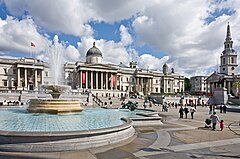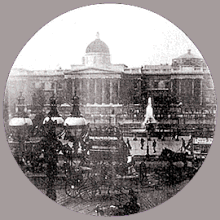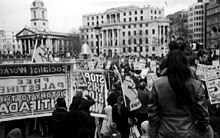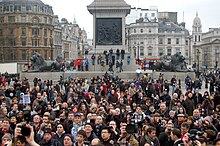TOO MANY PIDGEONS!!! They were like kamakawsi pidgeons. I was glad to take pictures and leave and I was afraid I'd end up with bird doo on my head. The statues are lovely - but the square feels like a bio hazard.
I remembered people allowing their children to climb on the lions (4 guard the square). I thought it was rude and thought it was illegal. It wasnt. Its a thing people do. Not me though. 1st the bio-hazard and secondly, if a child fell (it was over a grown persons head), they could be hurt on the concrete. I can't wait to go back.
Trafalgar Square

View of the square in 2009
|
|
| Former name(s) | Charing Cross |
|---|---|
| Namesake | Battle of Trafalgar |
| Maintained by | Greater London Authority |
| Location | City of Westminster, London, England |
| Postal code | WC2 |
| Coordinates | 51.508056°N 0.128056°WCoordinates: 51.508056°N 0.128056°W |
| North | Charing Cross Road |
| East | The Strand |
| South | Northumberland Avenue Whitehall |
| West | The Mall |
| Construction | |
| Completion | c. 1840 |
| Other | |
| Designer | Sir Charles Barry |
| Website | www |
The site of Trafalgar Square had been a significant landmark since the 13th century and originally contained the King's Mews. After George IV moved the mews to Buckingham Palace, the area was redeveloped by John Nash, but progress was slow after his death, and the square did not open until 1844. The 169-foot (52 m) Nelson's Column at its centre is guarded by four lion statues. A number of commemorative statues and sculptures occupy the square, but the Fourth Plinth, left empty since 1840, has been host to contemporary art since 1999.
The square has been used for community gatherings and political demonstrations, including Bloody Sunday, the first Aldermaston March, anti-war protests, and campaigns against climate change. A Christmas tree has been donated to the square by Norway since 1947 and is erected for twelve days before and after Christmas Day. The square is a centre of annual celebrations on New Year's Eve. It was well known for its feral pigeons until their removal in the early 21st century.
Geography
Trafalgar Square is owned by the Queen in Right of the Crown[a] and managed by the Greater London Authority, while Westminster City Council owns the roads around the square, including the pedestrianised area of the North Terrace.[2] The square contains a large central area with roadways on three sides and a terrace to the north, in front of the National Gallery. The roads around the square form part of the A4, a major road running west of the City of London.[3] The square was formerly surrounded by a one-way traffic system, but works completed in 2003 reduced the width of the roads and closed the northern side to traffic.[4]Nelson's Column is in the centre of the square flanked by fountains designed by Sir Edwin Lutyens between 1937 and 1939[5] as replacements for two fountains of Peterhead granite (now in Canada) and guarded by four monumental bronze lions sculpted by Sir Edwin Landseer.[6] At the top of the column is a statue of Horatio Nelson who commanded the British Navy at the Battle of Trafalgar.
Surrounding the square are the National Gallery on the north side and St Martin-in-the-Fields Church to the east.[6] To the south west is The Mall leading towards Buckingham Palace via Admiralty Arch, while Whitehall is to the south and the Strand to the east. Charing Cross Road passes between the National Gallery and the church.[3]
London Underground's Charing Cross tube station on the Northern and Bakerloo lines has an exit in the square. The lines had separate stations, of which the Bakerloo line one was called Trafalgar Square until they were linked and renamed in 1979 as part of the construction of the Jubilee line,[7] which was rerouted to Westminster tube station in 1999.[8] Other nearby tube stations are Embankment connecting the District, Circle, Northern and Bakerloo lines, and Leicester Square on the Northern and Piccadilly lines.[9]
London bus routes 3, 6, 9, 11, 12, 13, 15, 23, 24, 29, 53, 87, 88, 91, 139, 159, 176, 453 pass through Trafalgar Square.[10]
History
A painting by James Pollard showing the square before the erection of Nelson's Column
The site of Trafalgar Square has been a significant location since the 13th century. During Edward I's reign, the area was the site of the King's Mews, running north from the original Charing Cross, where the Strand from the City met Whitehall coming north from Westminster.[14] From the reign of Richard II to that of Henry VII, the mews was at the western end of the Strand. The name "Royal Mews" comes from the practice of keeping hawks here for moulting; "mew" is an old word for this. After a fire in 1534, the mews were rebuilt as stables, and remained here until George IV moved them to Buckingham Palace.[15]
Clearance and development
After 1732, the King's Mews were divided into the Great Mews and the smaller Green Mews to the north by the Crown Stables, a large block, built to the designs of William Kent. Its site is occupied by the National Gallery.[16] In 1826 the Commissioners of H.M. Woods, Forests and Land Revenues instructed John Nash to draw up plans for clearing a large area south of Kent's stable block, and as far east as St Martin's Lane. His plans left open the whole area of what became Trafalgar Square, except for a block in the centre, which he reserved for a new building for the Royal Academy.[17] The plans included the demolition and redevelopment of buildings between St Martin's Lane and the Strand and the construction of a road (now called Duncannon Street) across the churchyard of St Martin-in-the-Fields.[18] The Charing Cross Act was passed in 1826 and clearance started soon after.[17] Nash died soon after construction started, impeding its progress. The square was to be named for William IV commemorating his ascent to the throne in 1830.[19] Around 1835, it was decided that the square would be named after the Battle of Trafalgar as suggested by architect George Ledwell Taylor, commemorating Nelson's victory over the French and Spanish in 1805 during the Napoleonic Wars.[14][20]
Ten frames of Trafalgar Square shot by Wordsworth Donisthorpe in 1890
Trafalgar Square was opened to the public on 1 May 1844.[26]
Nelson's Column
The lions at Nelson's Column were not finished until nearly 30 years after the square opened.
The last of the bronze reliefs on the column's pedestals was not completed until May 1854, and the four lions, although part of the original design, were only added in 1867.[29] Each lion weighs seven tons.[30] A hoarding remained around the base of Nelson's Column for some years and some of its upper scaffolding remained in place.[31] Landseer, the sculptor, had asked for a lion that had died at the London Zoo to be brought to his studio. He took so long to complete sketches that its corpse began to decompose and some parts had to be improvised. The statues have paws that resemble cats more than lions.[32]
Barry was unhappy about Nelson's Column being placed in the square. In July 1840, when its foundations had been laid, he told a parliamentary select committee that "it would in my opinion be desirable that the area should be wholly free from all insulated objects of art".[22]
In 1940 the Nazi SS developed secret plans to transfer Nelson's Column to Berlin[b] after an expected German invasion, as related by Norman Longmate in If Britain Had Fallen (1972).[33]
The square has been Grade I listed on the Register of Historic Parks and Gardens since 1996.[34]
Redevelopment
A major 18-month redevelopment of the square led by W.S. Atkins with Foster and Partners as sub-consultants was completed in 2003. The work involved closing the eastbound road along the north side and diverting traffic around the other three sides of the square, demolishing the central section of the northern retaining wall and inserting a wide set of steps to the pedestrianised terrace in front of the National Gallery. The construction includes two lifts for disabled access, public toilets and a café. Access between the square and the gallery had been by two crossings at the northeast and northwest corners.[35][36]Statues and monuments
Plinths
Barry's scheme provided two plinths for sculptures on the north side of the square.[37] A bronze equestrian statue of George IV by Sir Francis Chantrey, originally intended to be placed on top of the Marble Arch,[17] was installed on the eastern plinth in 1844, while the other remained empty until the late-20th century.[37] There are two other statues on plinths, both installed during the 19th century: General Sir Charles James Napier by George Cannon Adams in the south-west corner in 1855, and Major-General Sir Henry Havelock by William Behnes in the south-east in 1861.[17] In 2000, the Mayor of London, Ken Livingstone, suggested replacing the statues with figures more familiar to the general public.[38]Fourth plinth
In the 21st century, the empty plinth in the north-west corner of the square, the "Fourth Plinth", has been used to show specially commissioned artworks. The scheme was initiated by the Royal Society of Arts and continued by the Fourth Plinth Commission, appointed by the Mayor of London.[39]A new sculpture, The Gift Horse designed by Hans Haacke was installed on the fourth plinth on 5 March 2015. It is a model of a horse's skeleton with a live display of the London Stock Exchange.[40]
Other sculptures
There are three busts of admirals against the north wall of the square. Those of Lord Jellicoe by Sir Charles Wheeler and Lord Beatty, by William MacMillan were installed in 1948 in conjunction with the square's fountains, which also commemorate them.[41][42] The third, of the Second World War First Sea Lord Admiral Cunningham by Franta Belsky was unveiled alongside them on 2 April 1967.[43]On the south side on the site of the original Charing Cross, is a bronze equestrian statue of Charles I by Hubert Le Sueur. It was cast in 1633, and placed in its present position in 1678.[44]
The two statues on the lawn in front of the National Gallery are the statue of James II by Grinling Gibbons to the west of the portico, and of one George Washington, a replica of a work by Jean-Antoine Houdon, to the east[36] that was a gift from the Commonwealth of Virginia installed in 1921.[45]
Two statues erected in the 19th century have since been removed. One of Edward Jenner, pioneer of the smallpox vaccine, was set up in the south-west corner of the square in 1858, next to that of Napier. Sculpted by William Calder Marshall, it showed Jenner sitting in a chair in a relaxed pose, and was inaugurated at a ceremony presided over by Prince Albert. It was moved to Kensington Gardens in 1862.[46][47] The other, of General Charles George Gordon by Hamo Thornycroft, was erected on an 18-foot high pedestal between the fountains in 1888. It was removed in 1943 and re-sited on the Victoria Embankment ten years later.[48]
Fountains
Fountain at Trafalgar Square, 2014
In the late-1930s it was decided to replace the pump and the centrepieces of the fountains. The new centrepieces, designed by Sir Edwin Lutyens, were memorials to Lord Jellicoe and Lord Beatty, although busts of the admirals, initially intended to be placed in the fountain surrounds were placed against the northern retaining wall when the project was completed after the Second World War.[50] The fountains cost almost £50,000. The old ones were presented to the Canadian government and are now located in Ottawa's Confederation Park and Regina's Wascana Centre.[51][52]
A programme of restoration was completed by May 2009. The pump system was replaced with one capable of sending an 80-foot (24 m) jet of water into the air.[53] A LED lighting system that can project different combinations of colours on to the fountains was installed to reduce the cost of lighting maintenance and to coincide with the 2012 Summer Olympics.[51]
Pigeons
People sitting on lions and feeding pigeons in the square
In February 2001, the sale of bird seed in the square was stopped[55] and other measures were introduced to discourage the pigeons including the use of birds of prey.[58] Supporters continued to feed the birds but in 2003 the mayor, Ken Livingstone, enacted bylaws to ban feeding them in the square.[59] In September 2007 Westminster City Council passed further bylaws banning feeding birds on the pedestrianised North Terrace and other pavements in the area.[60] Nelson's column was repaired from years of damage from pigeon droppings at a cost of £140,000.[57]
Events
New Year
For many years, revellers celebrating the New Year have gathered in the square despite a lack of celebrations being arranged. The lack of official events was partly because the authorities were concerned that encouraging more partygoers would cause overcrowding. Since 2003, a firework display centred on the London Eye and South Bank of the Thames has been provided as an alternative. Since 2014, New Year celebrations have been organised by the Greater London Authority in conjunction with the charity Unicef, who began ticketing the event to control crowd numbers.[61]Christmas
The Trafalgar Square Christmas tree in 2008
The Christmas tree is decorated with lights that are switched on at a seasonal ceremony.[63] It is usually held twelve days before Christmas Day. The festivity is open to the public and attracts a large number of people.[64] The switch-on is usually followed by several nights of Christmas carol singing and other performances and events.[65] On the twelfth night of Christmas, the tree is taken down for recycling. Westminster City Council threatened to abandon the event to save £5,000 in 1980 but the decision was reversed.[62]
The tree is selected by the Head Forester from Oslo's municipal forest and shipped, across the North Sea to the Port of Felixstowe, then by road to Trafalgar Square. The first tree was 48 feet (15 m) tall, but more recently has been around 75 feet (23 m). In 1987, protesters chained themselves to the tree.[62] In 1990, a man sawed into the tree with a chainsaw a few hours before a New Year's Eve party was scheduled to take place. He was arrested and the tree was repaired by tree surgeons who removed gouged sections from the trunk while the tree was suspended from a crane.[66]
Political demonstrations
A demonstration in Trafalgar Square
The Campaign for Nuclear Disarmament's first Aldermaston March, protesting against the Atomic Weapons Establishment (AWE), began in the square in 1958.[36] One of the first significant demonstrations of the modern era was held in the square on 19 September 1961 by the Committee of 100, which included the philosopher Bertrand Russell. The protesters rallied for peace and against war and nuclear weapons. In March 1968, a crowd of 10,000 demonstrated against US involvement in the Vietnam War before marching to the American Embassy in Grosvenor Square.[68]
Protesting against harassment of photographers under anti-terrorism law, 23 January 2010
In December 2009, participants from the Camp for Climate Action occupied the square for the two weeks during which the UN Conference on Climate Change took place in Copenhagen.[71] It was billed as a UK base for direct action on climate change and saw various actions and protests stem from the occupation.[72][73][74]
In March 2011, the square was occupied by a crowd protesting against the UK Budget and proposed budget cuts. During the night the situation turned violent as the escalation by riot police and protesters damaged portions of the square.[75] In November 2015 a vigil against the terrorist attacks in Paris was held. Crowds sang the French national anthem, La Marseillaise, and held banners in support of the city and country.[76]
Every year on the anniversary of the Battle of Trafalgar (21 October), the Sea Cadet Corps holds a parade in honour of Admiral Lord Nelson and the British victory over the combined fleets of Spain and France at Trafalgar.[77] The Royal British Legion holds a Silence in the Square event on Armistice Day, 11 November, in remembrance of those who died in war. The event includes music and poetry readings, culminating in a bugler playing the Last Post and a two-minute silence at 11 am.[78]
Sport
In the 21st century, Trafalgar Square has been the location for several sporting events and victory parades. In June 2002, 12,000 people gathered to watch the England national football team's World Cup quarter-final against Brazil on giant video screens which had been erected for the occasion.[79] The square was used by the England national rugby union team on 9 December 2003 to celebrate their victory in the 2003 Rugby World Cup,[80] and on 13 September 2005 for the England national cricket team's victory in the Ashes series.[81]On 6 July 2005 Trafalgar Square hosted the announcement of London's bid to host the 2012 Summer Olympics.[82] A countdown clock was erected in March 2011, although engineering and weather-related faults caused it to stop a day later.[83] In 2007, it hosted the opening ceremonies of the Tour de France[84] and was part of the course for subsequent races.[85]
Other uses
Trafalgar Square temporarily grassed over in May 2007
As an archetypal London location, Trafalgar Square featured in film and television productions during the Swinging London era of the late 1960s, including The Avengers,[87] Casino Royale,[88] Doctor Who,[89] and The Ipcress File.[90] It was used for filming several sketches and a cartoon backdrop in the BBC comedy series Monty Python's Flying Circus.[91] In May 2007, the square was grassed over with 2,000 square metres of turf for two days in a campaign by London authorities to promote "green spaces" in the city.[92]
In July 2011, due to building works in Leicester Square, the world premiere of the final film in the Harry Potter series, Harry Potter and the Deathly Hallows – Part 2, was held in Trafalgar Square, with a 0.75-mile (1.21 km) red carpet linking the squares. Fans camped in Trafalgar Square for up to three days before the premiere, despite torrential rain. It was the first premiere ever to be held there.[93]


















No comments:
Post a Comment